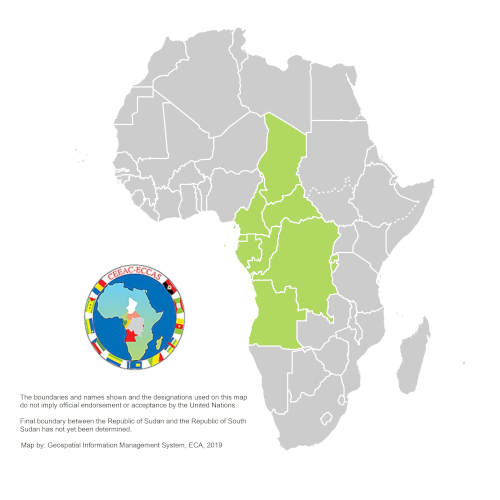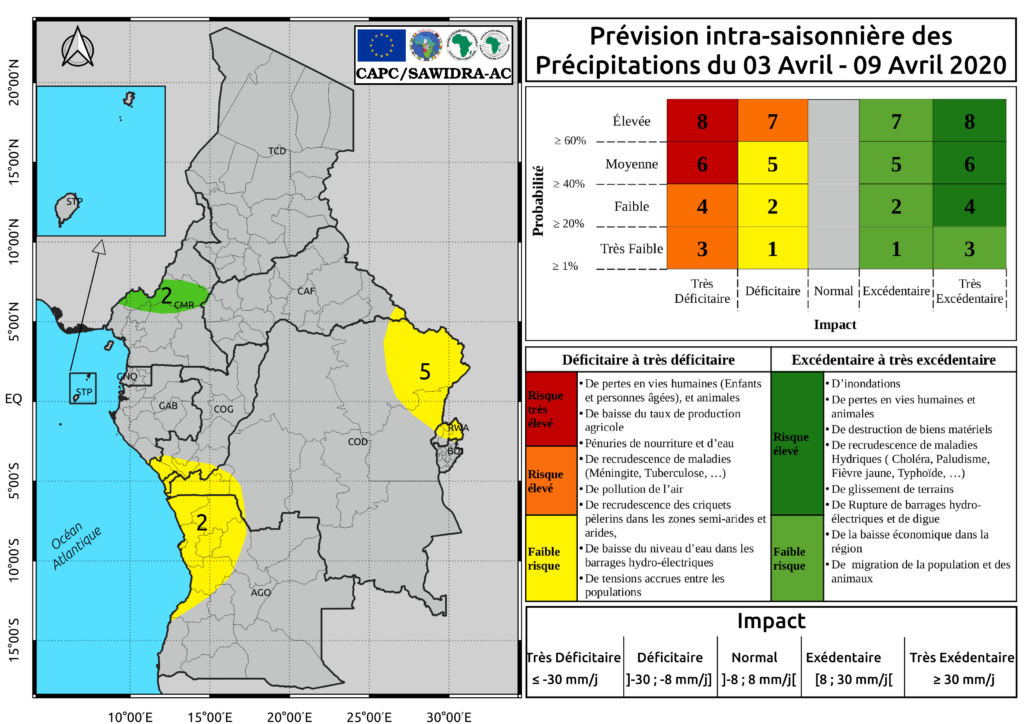By Joshua Talib (UKCEH), Cheikh Dione (ACMAD) and Pascal Moudi Igri (CACP-AC) for African SWIFT
In May 2015 the Central African Climate Application and Prediction Centre (CACP-AC) was formed in Cameroon to provide the latest weather forecast products and climate services to countries in the Economic Community of Central African States (ECCAS).
ECCAS contains eleven countries including Angola, Burundi, Cameroon, Central African Republic, Chad, Congo, Democratic Republic of the Congo, Equatorial Guinea, Gabon, Rwanda, and Sao Tome and Principe (Figure 1).


Countries across Central Africa contain some of the world’s poorest livelihoods and frequently experience extreme hydrometeorological events.
The region also contains a variety of environments including the Angola desert, Congolian rainforests, regions of the Sahel in northern Cameroon and Chad, and highly-populated cities such as Douala in Cameroon (Figure 2) and Kinshasa in Democratic Republic of Congo.
African SWIFT scientists improve sub-seasonal forecasts in Central Africa
African SWIFT scientists, in particular those from African Centre of Meteorological Application for Development (ACMAD) and UK Centre of Ecology and Hydrology (UKCEH), are working with CAPC weather forecasters to improve forecasting practices, enhance the communication of early warnings, and reduce the vulnerability to extreme hydrometeorological events.
Whilst African SWIFT scientists are supporting weather forecasting techniques at CAPC across a range of timescales, the partnership between CAPC and African SWIFT has mostly focussed on improving sub-seasonal forecasts.
The collaboration between CAPC and African SWIFT developed as part of the African SWIFT sub-seasonal to seasonal testbed which launched in November 2019.
Sub-seasonal forecasts have a typical timeframe of one to four weeks and predict the upcoming dominating weather regimes. A sub-seasonal forecast should correctly predict synoptic regions with a high probability of heavy rainfall but will struggle to predict the location of single thunderstorm.
CAPC provides sub-seasonal forecast bulletins to different ministries in ECCAS member states to highlight regions with forecasted extreme precipitation anomalies (Figure 3). For example, forecasts are sent to the National Meteorological and Hydrological Services director in Gabon, who will advise agriculture, energy, and waste management industries, to name a few, on the appropriate actions to be taken.

Before collaborating with African SWIFT scientists, forecasters at CAPC solely relied on sub-seasonal predictions from National Centers for Environmental Prediction (NCEP) Climate Forecast System (CFS) version 2 (Saha et al., 2010) and National Oceanic and Atmospheric Administration (NOAA) Subseasonal Experiment (SubX) project.
African SWIFT products deemed most-trusted for Central Africa
Using real-time forecast data provided through the Subseasonal to Seasonal Project Real-time Pilot Initiative, African SWIFT scientists are providing CAPC with reliable, customised sub-seasonal predictions from the European Centre for Medium-range Weather Forecasts (ECMWF).
Every week African SWIFT scientists provide a catalogue of products to CAPC including forecasted anomalies in temperature and wind, and the probability of precipitation extremes.
For example, Figure 4 shows the probability of anomalous high and low rainfall during the upcoming weeks in the forecast initialised on the 23rd March 2020. Precipitation and probability thresholds were chosen after discussions with CAPC. Using products from the developed catalogue, and other forecast sources discussed above, CAPC provides accessible and useful climate information to their users.

Figure 3 is an example of one of the bulletins produced at CAPC and highlights minimal precipitation during 3 and 9 April 2020 across north-eastern and western Democratic Republic of Congo, north-western Angola, western Chad, and southern Congo. Feedback from CAPC forecasters highlight that developed products produced by African SWIFT scientists are their most trusted products available and have greatly improved the production of sub-seasonal forecast bulletins.
Partnership continues building forecasting capability in Central Africa
Throughout the next year we plan to strengthen the collaboration between African SWIFT and CAPC to further improve weather forecasting across Central Africa and enhance the response to warnings of hydrometeorological events.
Over the past few decades African meteorological research has focussed on West Africa and East Africa. The collaboration with CAPC encourages meteorology and climate scientists to develop our understanding of atmospheric processes across Central Africa.
In the final year of African SWIFT, we hope to evaluate sub-seasonal forecasts across Central Africa, further improve forecasting practices at CAPC, and provide a foundation for professional relationships to enable future Central Africa meteorological research.
For questions about the partnership or for information about collaborating with African SWIFT, contact the African SWIFT project office by email at ncasswift@leeds.ac.uk.
References
Saha, S., S. Nadiga, C. Thiaw, J. Wang, W. Wang, Q. Zhang, H.M. Van Den Dool, H.-L. Pan, S. Moorthi, D. Behringer, D. Stokes, M. Pena, S. Lord, G. White, W. Ebisuzaki, P. Peng, and P. Xie, 2006: The NCEP Climate Forecast System. J. Climate 19 (15): 3483-3517.
About the Authors
Dr Joshua Talib is a research associate from the UK Centre for Ecology and Hydrology (UKCEH). His primary role is to investigate whether understanding land-atmosphere interactions can improve sub-seasonal weather forecasts. For the African SWIFT project, Joshua supports collaborations in Central and East Africa alongside researching land-atmosphere feedbacks associated with intraseasonal variability. He holds a PhD in the Department of Meteorology (University of Reading), which focussed on understanding the mechanisms controlling tropical rainbelts.
Dr Cheikh Dione is a research scientist at African Centre of Meteorological Applications for Development (ACMAD). Within the African SWIFT programme, Cheikh works on sub-seasonal to seasonal forecasting, and satellite remote sensing and nowcasting. His research covers a large range of meteorology and climatology, including local and large scale convection, gust fronts, land surface heterogeneity, atmospheric boundary layer processes, weather regimes, and climate impact. Research Gate Profile.
Dr Pascal Moudi Igri is a numerical weather prediction expert at the Central African Climate Application and Prediction Centre (CAPC-AC) and is a member of the World Meteorological Organisation’s expert team. He is an engineer in applied meteorology (aviation) and holds a PhD in Atmospheric and Environmental Science. Research Gate Profile.
